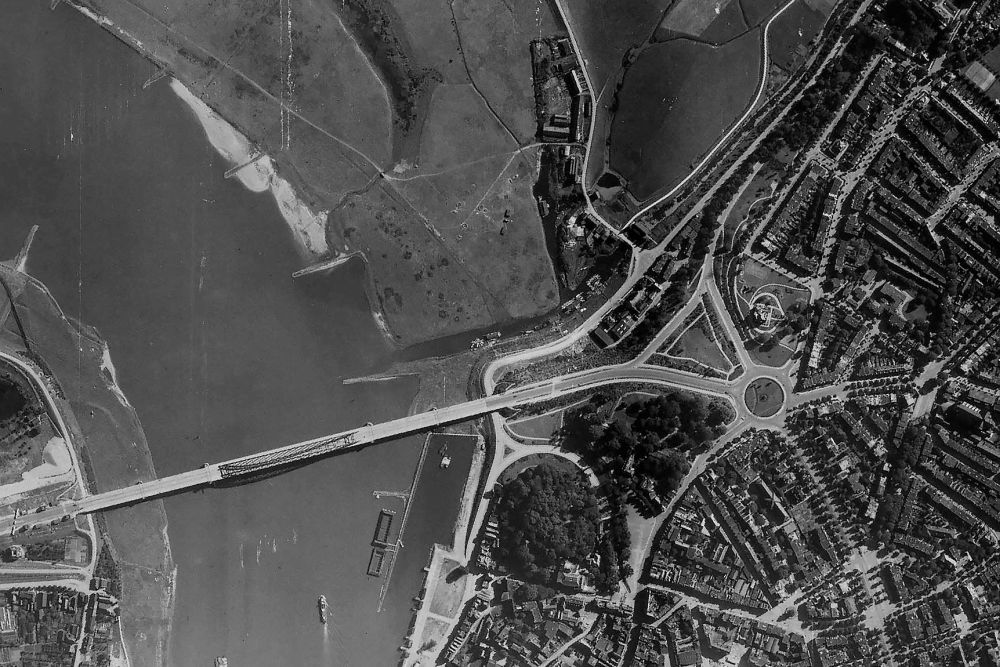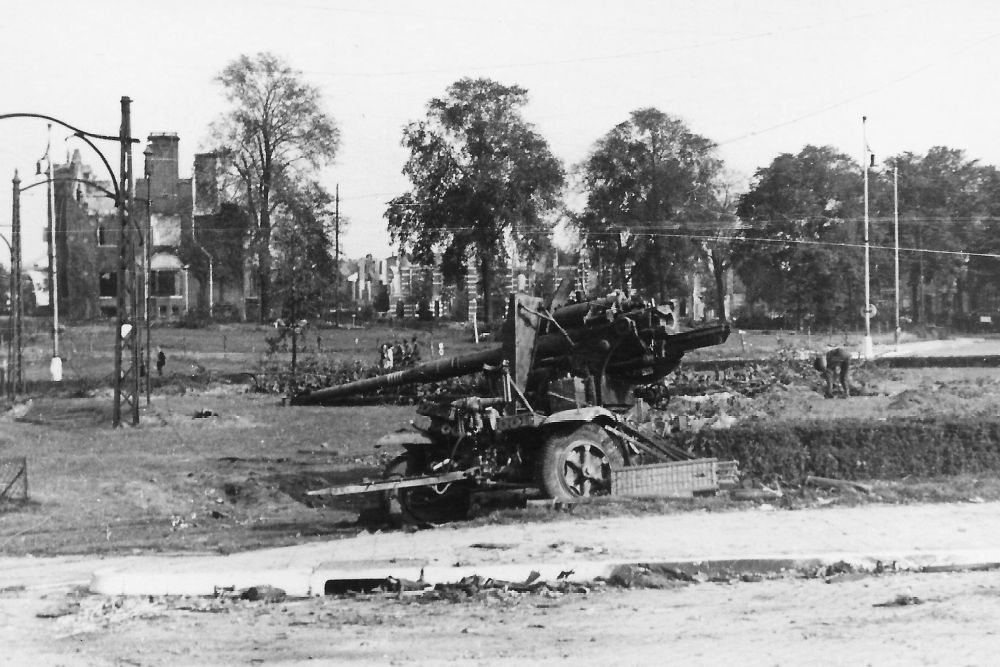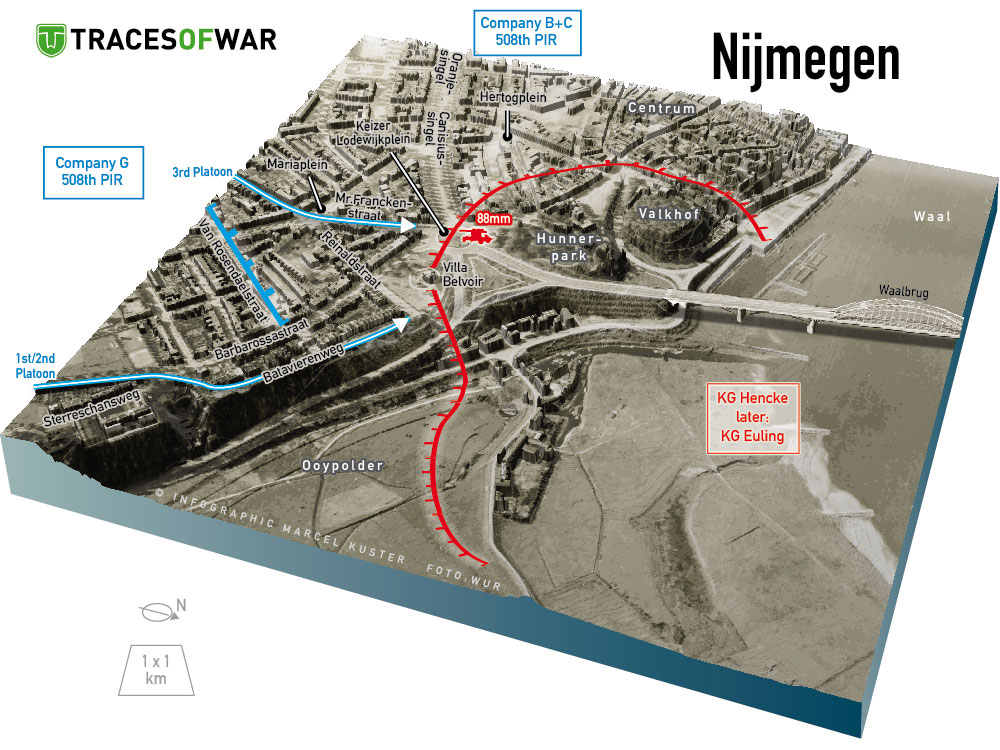Introduction
In the early morning of September 18, 1944, the second day of Operation Market Garden, Company G of the US 508th PIR made a second attempt to take control of the Waalbrug, the road bridge at Nijmegen along an eastern approach route. In the evening of September 17, 1944, Company A and Company B of this regiment had launched a first attack on this bridge in an attempt to capture it. This first attack had stalled in the centre of Nijmegen and only a few small groups of paratroopers had managed to reach the bridge. Although in this second attack they managed to get much closer to it, German resistance had become such that this attack also came to a halt.
Definitielijst
- paratroopers
- Airborne Division. Military specialized in parachute landings.
- regiment
- Part of a division. A division divided into a number of regiments. In the army traditionally the name of the major organised unit of one type of weapon.
- resistance
- Resistance against the enemy. Often also with armed resources.
Company G, 508th PIR in Nijmegen
During Operation Market Garden, the American 82nd Airborne Division had, among other things, the task of capturing a number of bridges in and around Nijmegen. One of those bridges was the road bridge over the river Waal at Nijmegen, popularly known as the Waalbrug. It would eventually take four attempts before this bridge came into Allied hands intact.
In the early morning of September 18, 1944, Company G of the 508th PIR launced an attack in a second attempt to capture the bridge. The day before, in the evening of September 17, 1944, a first attack was launched by that regiment, following the insistence of General James Gavin. Company A and Company B conducted this attack from the south-east of the city via a route through the centre of town. This attack stalled at the Keizer Karelplein, although smaller groups still managed to penetrate to the Keizer Lodewijkplein, close to the Waalbrug itself. However, due to the increasingly solid German defences, they got hopelessly bogged down. During the night of September 17, to 18, the units were reorganised and the aim was to launch a renewed attack with Company B, Company C and Company G in the morning of September 18, 1944. Due to the situation on the landing zone north of Groesbeek, elements of 508th PIR were recalled to the area on that morning to clear it for the planned glider landings.
In most recorded history, the next attempts to capture the Waalbrug (road bridge) or the Waal bridges (railway and road ) are considered to be the joint attempt of the 82nd Airborne Division and the Grenadier Guards Division on September 19, 1944 (this attempt failed) and the eventual capture of the Waalbruggen on September 20, 1944. It is much less known that in the morning of September 18 1944, Company G of the 508th PIR made an attempt to capture the Waalbrug (road bridge).

Aerial view of the area around the Waalbrug (left) with Keizer Lodewijkplein (roundabout) and Villa Belvoir (above the roundabout), Company G's battleground. Source: Public Domain (unknown)
The 3rd Battalion of the 508th PIR, commanded by Lieutenant-Colonel Louis G. Mendez, landed just south-east of the landing zone at 13:36,[1] their objective was to close off the access roads via Berg en Dal and protect the landing zone along that road. By 15.30 they had occupied Berg en Dal and at 18.30 Company G, commanded by Captain Russell C. Wilde, moved towards the Waalbrug[2] on a reconnaissance mission. A platoon of Company I, commanded by 2nd Lieutenant William D. Bush Jr. reconnoitred the outskirts of Nijmegen near Berg en Dal and reported around 20:00 that it met almost no resistance. By nightfall, Company G moved into position at Heuvel 64.6 (on Pompweg, Ubbergen), 0.9 miles from the bridge. Orders known at the time initially prevented Company G from advancing further. Nevertheless, Captain Russell C. Wilde ordered a patrol, consisting of Angel Romero, Merle Beach, George McGraph and an S-2 man from 3rd Battalion to reconnoitre the bridge. They did not find any German opposition towards the bridge.[3]
20-year-old resistance member Agardus Marinus Leegsma Jr. had learned about the landings that evening and had already heard gunfire from the direction of Berg en Dal. Early the next morning, Agardus and his brother Joop set off early and for Agardus the world would not be the same after this.
Definitielijst
- regiment
- Part of a division. A division divided into a number of regiments. In the army traditionally the name of the major organised unit of one type of weapon.
- resistance
- Resistance against the enemy. Often also with armed resources.
Attack on the bridge
During the first attack on the Waalbrug, at 03.00 on September 18, 1944, a squad from Company C of the 1st Battalion, 508th PIR had approached a German artillery position at Mariaplein on Berg en Dalseweg. After encircling the Germans via Ten Hoetstraat, about 20 German soldiers fled via Meester Franckenstraat to Keizer Lodewijkplein. The unit then moved on via Straalmanstraat and Regentessestraat towards Keizer Lodewijkplein. Meanwhile, another unit had reached the corner of Museum Kamstraat and Barbarossastraat, with German troops leaving their machinegun position there without any resistance. The groups from Company C then left at 08.00 to join Company A and Company B at Keizer Karelplein to prepare for a renewed joint attack on the Waalbrug.
In the meantime, Lieutenant-Colonel Mendez had decided of his own accord to instruct Company G to take the Waalbrug by means of an attack via the east side from their starting point at Hill 64. A reconnaissance group of four men, was sent forward. The group was the same as the one that made the last reconnaissance the previous day. They came into contact with Agardus Leegsma and his brother who offered to accompany them as guides.[4] The four soldiers took Agardus and his brother to the Company CP in the Kwakkenberg area. Captain Wilde asked the brothers to join them and Agardus would not leave the Americans from then on. Because the Americans had difficulties pronouncing his name, Agardus was called "Gas"[5] to them from that moment on. Two hours later, Company G set off towards the Waalbrug.
Lieutenant Howard A. Greenawalt was sent forward with the 3rd Platoon and seized a German hospital (Ed: possibly the Maartenskliniek) on the outskirts of Nijmegen, where a guard was left behind. After this, the advance continued. Company G approached the objective via the Berg en Dalseweg to the Huygensweg, where it had to stop because of snipers. Captain Wilde subsequently decided to divide his company into two groups.[6] In the fighting to eliminate the snipers, Staff Sergeant Stanley E. Stevens distinguished himself, but was killed in the process.

American Paras of Company G on the corner of Berg en Dalseweg and Jozef Israëlstraat hiding from snipers. Source: Frans Peters / Photo Collection Regionaal Archief Nijmegen
Captain Wilde ordered Lieutenant Howard A. Greenawalt, with Staff Sergeant Stanley E. Stevens and three men from 3rd Platoon to go through the gardens and eliminate the snipers. The platoon was then able to advance as far as Mariaplein. Here they encountered a group of Germans who were building a roadblock at the time. The Americans immediately attacked, destroying the blockade and killing seven Germans. Advancing along Meester Franckenstraat to the intersection with Regentessestraat-Straalmanstraat, they came under fire from mortars and a 88mm gun firing from Keizer Lodewijkplein and had to take cover here[7]. At that time, only one platoon had reached Keizer Lodewijkplein and there were already five casualties.[8] Captain Wilde and "Gas" Agardus Leegsma climbed to the top floor of a house to survey the bridge and the area in front of it. Just then, American paratroopers tried to make their way towards the bridge. They came face to face with the newly arrived men from Kampfgruppe Hencke which had just reinforced the defences around the bridge. The German flak was so intense that several Americans were wounded. Most of the wounded were taken care of several miles back at St Canisius Hospital by Dr C.H. ter Horn[9].
Meanwhile the other units, 1st and 2nd Platoon, had advanced along the right flank, via Huygensweg to Ubbergseveldweg and then via that road to Museum Kamstraat, where a German position with two machineguns was cleared with the help of a Bazooka. Continuing, several more German pockets of resistance were cleared and by 09.30 they had reached a position near the Batavierenweg behind Villa Belvoir[10]. In the meantime, Company G had maintained radio contact with Company B and Company C so that, from their starting positions near the Keizer Karelplein, they could join their attack as soon as they started their second attempt to attack the Waalbrug.
Around 10.00, the advance of Company G was under constant mortar fire from the Germans from the defences around the Waalbrug and the Ooypolder. Meanwhile, the Americans also took up positions on the roof of Barbarossastraat 9 and on the Sterreschansweg in order to bring heavier mortar and machinegun fire to bear on the German positions. In the process, a mortar position of the Germans in the Ooypolder was destroyed from the Sterreschansweg[11]. On the right flank, Company G moved on via Reinaldstraat, which was reached at 10.30, after which several houses on Reinaldstraat and Graadt van Roggenstraat were occupied via the back gardens. From here they had an excellent view of the German positions at Keizer Lodewijkplein and Hunnerpark. At the corner of Dr Claes Noorduynstraat and Barbarossastraat, on the grounds of the Technical Assistance Service, a 60mm mortar was set up from which the German positions could be bombarded. During these actions, a piece of artillery on Keizer Lodewijkplein was put out of action[12] (Ed.: in various literature, it is often suggested that this was the 88mm gun positioned in the middle of Keizer Lodewijkplein. If this was the case, this gun was later replaced by another 88 as on September 19 1944, another attack was also stopped by an 88mm firing from Keizer Lodewijkplein).
By 10.30, it seemed that the renewed attack by Company B and Company C from Keizer Karelplein would finally get off the ground. A platoon of Company B, attacking over Oranjesingel, reached Ziekerstraat, while another platoon reached Hertogplein via Bijleveldsingel, Prins Hendrikstraat and Hertogstraat. This attack caused around 100 Germans to retreat[13]. The attack stalled, however, when around 11.00 the order came to Company B to withdraw from Nijmegen and move towards the landing area which at that time came under threat of attack from the German Reichswald.
Due to the pressure on the German defences around the Waalbrug that had been building up before, the German side was forced to reorganise. Kampfgruppe Reinhold, had arrived in Nijmegen via Pannerden at that time. SS-Sturmbannführer Leo Reinhold himself took command of the troops in Nijmegen. Kampfgruppe Hencke (Oberst Friedrich (Fritz) Hencke) was ordered to take charge of the ramp to the railway bridge and Kampfgruppe Euling (SS-Hauptsturmführer Karl-Heinz Euling) was given the task of defending the Waalbrug itself. The withdrawal of Company B from the centre gave the German defence the chance to regroup and increase the pressure on Company G[14]. The Germans managed to set up a machinegun emplacement on the corner of Oranjesingel with Van Der Brugghenstraat.
By 12.45, partly due to German artillery support from the Betuwe, the pressure on Company G had become such that they were forced to retreat to the Van Rosendaelstraat (nowadays southern part Hugo de Grootstraat). At 14.00, Company G was ordered to retreat to Hill 64, where they had to go into reserve[15]. Agardus Leegsma was issued with an American uniform and would continue to accompany Company G. His brother Joop had returned home earlier.

Some buildings on Hugo de Grootstraat (photo taken towards Berg en Dalseweg) destroyed during the liberation battle in September 1944. In the foreground the intersection Jan van Goyenstraat (left, formerly van Rosendaelstraat) and Ten Hoetstraat (right). Company G fought in this area. Source: Anna Huybers - Regionaal Archief Nijmegen, Netherlands
On the German side, the easing of pressure on the Waalbrug meant that the defences around the Waalbrug and of Nijmegen could be reinforced with troops of the 10. SS-Panzer-Division, the first units of which crossed the bridge.
Definitielijst
- Bazooka
- American antitank rocket launcher weapon. Rocket with shaped charge is put in a long tube which is electrically fired from the shoulder of an infantry man. The bazooka can be reloaded. The bazooka produces a large flame to the rear which makes it unsuitable for fighting from closed compartments or from homes. British counterpart is the PIAT, Projector Infantry, Anti- Tank, also a man-portable anti-tank weapon. Germany used Panzerfaust and Panzerschreck, “armour fist “ and “armour terror”.
- flak
- Flieger-/Flugabwehrkanone. German anti-aircraft guns.
- Kampfgruppe
- Temporary military formation in the German army, composed of various units such as armoured division, infantry, artillery, anti-tank units and sometimes engineers, with a special assignment on the battlefield. These Kampfgruppen were usually named after the commander.
- mortar
- Canon that is able to fire its grenades, in a very curved trajectory at short range.
- paratroopers
- Airborne Division. Military specialized in parachute landings.
- resistance
- Resistance against the enemy. Often also with armed resources.
- Waffen-SS
- Name of Military section of the SS.
Epilogue
On September 20 1944, the story of Agardus Marinus "Gas" Leegsma Jr. joining the Americans took a sad turn. After Agardus' brother Joop had already returned home on September 19, father [graveid]92821, Agardus Marinus Leegsma Sr.[graveid] became worried about his other son. As chief watchman of the fire brigade, he had a motorbike at his disposal and with this he went in his fireman's outfit to look for his son. As he drove along the Berg en Dalseweg towards Berg en Dal, he came under fire from the Kopsehof by American paratroopers. They thought they were dealing with a German motor scout because of the black fireman's uniform and black helmet. Father Leegsma died on the spot. When son Joop went looking for his father, he found his body just when Americans were about to bury him in a mass grave with German victims.
Notes
- Johnson, 1950, pag. 21
- Poulussen, 2011, pag. 26
- Boroughs, 2013, pag. 256
- Boroughs, 2013, pag. 257
- McManus, 2012
- Nordyke, 2005, pag. 63
- Poulussen, 2011, pag. 28
- Nordyke, 2005, pag. 63
- McManus, 2012
- Poulussen, 2011, pag. 28
- Poulussen, 2011, pag. 28
- Poulussen, 2011, pag. 28
- Poulussen, 2011, pag. 29
- Poulussen, 2011, pag. 29
- MacDonald, 2014
Definitielijst
- brigade
- Consisted mostly of two or more regiments. Could operate independently or as part of a division. Sometimes they were part of a corps instead of a division. In theory a brigade consisted of 5,000 to 7,000 men.
- paratroopers
- Airborne Division. Military specialized in parachute landings.
Information
- Article by:
- Wilco Vermeer
- Translated by:
- Edwin van de Sande
- Published on:
- 07-02-2023
- Last edit on:
- 30-09-2024
- Feedback?
- Send it!
Related books
Sources
- BOROUGHS, Z., The 508th Connection, Xlibris Corporation, 2013.
- MACDONALD, C.B., United States Army in WWII - Europe - the Siegfried Line Campaign, Pickle Partners Publishing, 2014.
- MCMANUS, J. C., September Hope, NAL Caliber, New York, U.S.A., 2012.
- NORDYKE, P., All American All the Way, Zenith Press, St. Paul, United States, 2005.
- POULUSSEN, R.G., Lost at Nijmegen, eigen uitgave, 2011.
- Expload, Rapport, Beek-Herinrichting Kalorama, Vooronderzoek en Risicoanalyse Vooronderzoek Conventionele Explosieven, 14 november 1027
- Johnson, Kenneth L., Supply Operations of the 508th Parachute Infantry Regiment (82d Airborne Division) in the invasion of Holland, Arnheim Operation, 15-19 September 1944 (Rhineland Campaign), Advanced Infantry Officers Course, 1949-1950










